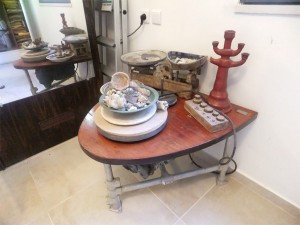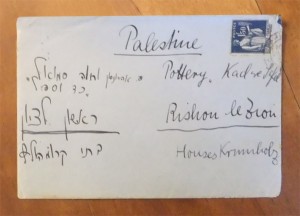An Appeal for Recognition and Dignity
“We used to throw stones at her – we thought she was a witch.” With these words, a former resident of Rishon LeZion ruefully told me of her childhood encounters with the sculptor and doll maker, Edith Samuel. Edith wore her long, dark, European skirts under the searing Middle Eastern sun and suffered from a physical deformity. The daughter of a liberal German rabbi, Edith and her sister Eva were both artists who left their home city of Essen in the 1930s and immigrated to Palestine.

The pottery wheel belonging to Paula Ahronson, Eva Samuel’s business partner, is preserved in private hands and untouched since her death in 1998
© Jewish Museum Berlin, photo: Michal Friedlander
The Samuel sisters worked long hours, struggled to earn a living and did not gain the recognition that they deserved, during their lifetimes. The exhibition “Tonalities” at the Jewish Museum Berlin aims to bring forgotten women artists back into the public arena. It presents Eva Samuel’s works and that of other women ceramicists who were forced to leave Germany after 1933.
My search for transplanted German, Jewish women in the applied arts began many years prior to my encounter with the Samuel sisters. It was Emmy Roth who first captured my attention. Born in 1885, Roth was an exceptionally talented and internationally successful silversmith, who worked in Berlin. She immigrated to Palestine and fell into obscurity, ultimately taking her own life in 1942. Her male refugee colleagues, Ludwig Wolpert and David Gumbel, were appointed to teach metalwork at the Jerusalem New Bezalel School of Art in the late 1930s. They are feted in Israel today, whereas Roth is still completely unknown there.

Envelope from a letter sent to the Kad ve-Sefel pottery, to the Krumholz or “crooked wood” house
© Jewish Museum Berlin, photo: Michal Friedlander
How could I find evidence of Roth in Palestine and of other overlooked women who are no longer alive? Where did they go when they left Germany? Had they changed their names? When I started my research, the Internet had few leads to offer me. I scoured historical Jewish publications from Britain, the United States and pre-State Palestine. I plodded through academic tomes and art catalogues looking for hints. I questioned colleagues, librarians, archivists, gallery owners, dealers, design experts and mentioned the project to just about anyone I met, to the point of being annoying.
Names and objects began to surface. One balmy Berlin evening, I sat next to an elderly man at an exhibition opening. We fell into conversation and he told me about his Jewish mother, who had worked in glass design. Would I be interested in seeing her work? Yes, indeed. In Jaffa, a grubby flea market dealer had piles of pre-State ceramics, but didn’t know how to decode the artists’ signatures. Would I like to accompany him on his moped to view his warehouse stock? Debatable. Nonetheless, I decided to focus my research on ceramicists and promptly found works by three different German émigré women in a single Israeli museum depot. The pieces were in perfect condition, but were caked in dust and had not been displayed since they entered the collections more than four decades ago.

Eva Samuel’s former ceramics studio in Rishon LeZion, Israel
© Jewish Museum Berlin, photo: Michal Friedlander
I made a pilgrimage to Rishon LeZion, south of Tel Aviv, where the Samuel siblings had settled. Here I found the dilapidated and abandoned hut where Eva Samuel had set up her ceramics studio. The exterior walls are covered in graffiti and the littered, vacant plot in which it sits is used for ad hoc parking. I am sure that the interior hasn’t changed much since Samuel closed down “Kad va-Sefel” (“Jug and Mug”) in 1979, after 45 years of business. When I enquired, I was told that there are currently no plans in effect to restore it. This fact only makes me more committed to continue searching for and collecting evidence of German, Jewish women who worked in the applied arts, before their traces are erased completely.
Do you have information about German Jews who were active in the applied arts (design, textiles, ceramics, metalwork, glass etc.)? If so, we would love to hear from you. Please contact: judaica@jmberlin.de.
Michal Friedlander, Curator of Judaica and Applied Arts
Have you ever heard of the ceramic artist Edythe Roth? I have come upon a piece of her work and was wondering if you might have any info on her. Thank you.